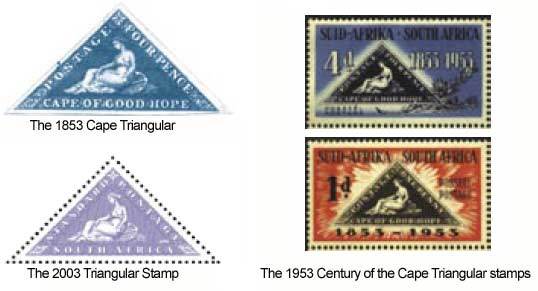Even a quick look at the Bob Shop South African stamps section reveals that starting a South African stamp collection can be a challenging proposition. That is because South African stamps closely mirror the history of the country.
South Africa's philately can be divided into three main sections:
Pre-Union stamps. The majority of the stamps from this period were issued by four main states: Cape of Good Hope, Natal, Orange Free State and Transvaal. The first (and the most famous) stamp from this period was issued in 1853, the triangular Cape of Good Hope stamp. It was the world's first triangular stamp and the first stamp issued by a country in Africa. Due to its exceptional design, it is still regarded as one of the world's classics.
The Union of South Africa stamps. The Union was formed on 31st May 1910 as an autonomously run dominion of the British Empire. The first stamp of the new country was issued on November 4th 1910 to commemorate the opening of the new Parliament. The first definitive set was issued on 1st September 1913, known as the King's Heads, because they depict the image of King George V. Between 1910 and 1913, the (now highly collectible) stamps of the four different Pre-Union states were also used across the country. In 1926, first bilingual pairs of stamps were issued.
The Republic of South Africa stamps. South Africa became an independent country on 31st May 1961. The new country got new currency, the Rand, and, naturally, new stamps. The new country¿s stamps are full of topical interest, with numerous issues stamps depicting wildlife, birds, transport and sport, to name just a few thematic areas.
But that is not all. A would-be collector of South African stamps may opt for thematic issues from the former Homelands. The Homelands were territories within South Africa administered by the native, African peoples. Ten self-governing territories were established for different black ethnic groups as part of the policy of apartheid, a system of legal racial segregation. Some of those territories were proclaimed as independent. Although the international community did not recognise Homelands as independent states, the Homeland stamps (from Bophuthatswana, Ciskei, Transkei, Venda, etc.) were accepted as valid on international mail. These former South African Homelands or Bantustans ceased to exist on 27 April 1994 and were re-incorporated into South Africa.
Modern South African stamps also have a lot to offer to a collector. The South African Post Office regularly issues thematic stamps featuring various aspects of the country and its people: wildlife, waterfalls, sporting events, South African Nobel Laureates, are only some of them.
Collecting stamps of South Africa is fun for the beginner and advanced collector alike. It has been a popular collecting area for many years, and collectors can make it as simple or as complicated as they wish.
